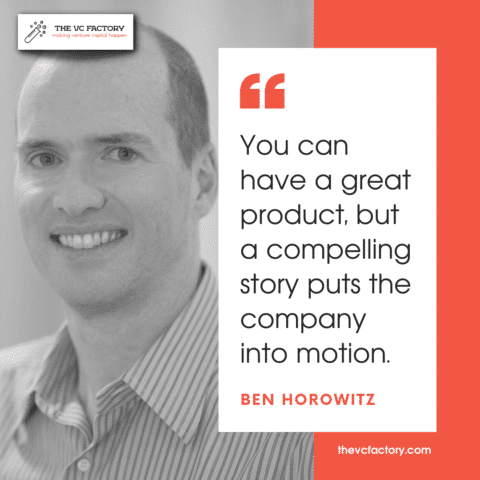“You can have a great product, but a compelling story puts the company into motion.” – Ben Horowitz

Having experienced both sides of the equation as an entrepreneur and now as a leading Venture Capitalist, Ben Horowitz is perfectly positioned to share invaluable insights and advice on the power of storytelling in business. Entrepreneurs need to frame their company’s journey—from inception through all growth stages—within a compelling story that resonates with Venture Capitalists.
In this post, I explore why Founders must hone their narrative skills to successfully raise funds from Venture Capitalists and provide concrete examples from real-life companies. By understanding the critical role storytelling plays in the fundraising process, entrepreneurs will be better equipped to captivate Investors and secure the funding needed to propel their businesses forward.
Why Storytelling is Crucial for Business Growth
Ben Horowitz, the eponymous co-founder of the elite early-stage VC firm Andreessen Horowitz, is a peculiar character in the otherwise soft-spoken world of Venture Capital. He seems to share his time between music—he’s often pictured next to famous hip hop artists—and successful entrepreneurs, who frequently quote his New York Times Bestseller The Hard Thing About Hard Things as their source of inspiration.
Horowitz knows how to get to the point. His LinkedIn profile humorously reads: “Horowitz at Andreessen Horowitz.”
The ability to tell a compelling story is a quality many startup Founders lack. Most entrepreneurs focus on the product rather than the company. They often fail to pitch their vision, the reason behind their company’s existence, and why customers should—and will—care.
The story must explain at a fundamental level why you exist.
Ben Horowitz – a16z (Source: Forbes)
A captivating narrative appeals to customers, Investors, and employees alike. It sets the stage for a company’s growth and shapes its trajectory. Effective storytelling makes people want to jump on the train.
However, building a strong narrative isn’t as easy as it sounds. It requires a deep understanding of the target audience, the company’s mission and vision, and the ability to articulate these ideas in a relatable and inspiring manner.
While the power of storytelling in the business world is undeniable, it is essential to understand the deeper roots of this phenomenon to truly appreciate its significance. To delve into the origins of storytelling and how it has shaped human evolution, we must explore the fascinating connections between our innate love for stories and their impact on our social and cognitive development. By examining this relationship, we can better comprehend why storytelling remains a crucial element in the success and growth of businesses today.
How Human Evolution Shaped Our Love for Storytelling
Throughout history, humans have been captivated by stories. From ancient oral tales like the Epic of Gilgamesh, the Iliad, and the Odyssey, stories have consistently captured our imagination and memory. Even infants and young children, known for their short attention spans, are enthralled by stories.
Anthropologists claim that storytelling and listening to tales are at the core of our species evolution. Humans possess an innate desire for social existence within a group, which offers resources, shelter, and a platform for storytelling—a powerful way to command attention and secure a vital role in group dynamics.
In his thought-provoking text, “The Origin of Stories: Horton Hears a Who,” Brian Boyd, a literature professor known for writing on human evolution, explores the evolutionary roots of storytelling by analyzing Dr. Seuss’s classic tale. Boyd posits that storytelling emerged as an adaptive mechanism, fulfilling various social and cognitive functions that ultimately enhance human cooperation and survival. By examining the tale of Horton, he reveals how stories can captivate our imagination, evoke emotions, and promote empathy, thus fostering social bonds and reinforcing group cohesion. Drawing from evolutionary theory, Boyd’s analysis illuminates the vital role that storytelling plays in human development and our innate desire to create and share narratives.
The truly unique trait of Sapiens is our ability to create and believe fiction.
Yuval Noah Harari (Source: Sapiens)
Contemporary studies on hunter-gatherer societies reveal that stories help coordinate social behavior and promote group cooperation. Researchers have also found that storytellers are preferred social partners and enjoy higher reproductive success.
Anthropologists also highlight the role of fire in fostering cooperation among early humans. Fire played a critical part in crafting communal stories and religious rituals, which in turn, seem to have encouraged cohesion in early human societies. The ability of Homo sapiens to undertake endeavors in larger groups than competing human species might stem from these shared beliefs.
Gathering around the fire at night (when there are no distractions) and listening to legendary tales appears to have spurred the creation of fiction, myths, legends, and other forms of shared stories. From time immemorial, stories have captured our attention, facilitated cooperation, aided survival by disseminating vital information about resources and potential dangers, and entertained us. The timeless appeal of storytelling remains an integral part of human evolution and our social fabric.
Having established the importance of storytelling in both business growth and human evolution, we can now turn our attention to a specific context where storytelling plays a pivotal role—Venture Capital pitch decks. By mastering the art of weaving a compelling narrative, entrepreneurs can greatly enhance their chances of securing the much-needed funding to propel their businesses forward.
Let’s explore how to captivate Venture Capitalists through the magic of storytelling in pitch decks.
The Art of Storytelling in Pitch Decks: How to Captivate Venture Capitalists
Over the years, fundraising pitch decks have evolved to become highly refined and effective tools for securing investments. They’ve reached a level of sophistication that some might even liken to works of art. (I know I do, and Founders I work with make fun of me. I think they’re right.)
Given the vast number of presentations VCs must sift through, they need a quick way to determine whether an investment opportunity merits further attention. Crafting a message into a compelling story can make that decision easier. Here’s a structure I commonly use:
- There is a real and large problem that [client category] needs to address urgently
- The current situation is suboptimal as [client category] is losing money / is losing an opportunity to make more money / has to abide by strict regulations quickly not to lose revenue
- Our solution helps customers answer the problem quickly, cost-effectively, and efficiently
- Although the market is huge, our insight is that the first segment to tackle is [customer segment name]
- We’ll go to market directly with our in-house sales team and will also rely on partners to reach our customers
- So far, we’ve built and tested a product, and we now know how to sell it, to whom to sell it, and at what price. Our business model is [describe it]
- We now need money to get to the next stage of our development: [describe milestones]
One defining moment for entrepreneurs in the pitch is to clearly outline why they care deeply about their venture. We know, as Investors, that when push comes to shove, only Founders who have a strong emotional attachment to the cause will persist long enough to find a solution.
Let’s consider an example of a compelling story to pitch VCs.
The Power of Storytelling in Pitching VCs: The Calendly Example
One product that has made a significant impact on my life is Calendly. It has saved me a considerable amount of time when it comes to organizing meetings with others. Let me share the Calendly story as a startup founder might tell it when pitching to VCs (numbers are invented):
Problem. “Today’s professionals spend 10% of their working time managing meeting slots with colleagues and partners. A key insight we discovered is that much of this time is consumed not in the initial effort to find a meeting slot, but in potential subsequent changes due to scheduling conflicts.”
Solution. “Our web-based solution helps professionals communicate slots based on their general calendar preferences while allowing the other party to reschedule a meeting in one click.”
Market & Business Model. “The market is worth [x] billion dollars, and we’re starting with freelance professionals and small firms that don’t use Outlook or similar calendar clients, which have shown better adoption rates so far. Our go-to-market strategy follows a typical B2C approach, but we benefit from a viral component: when someone starts using Calendly for their meetings, we noticed that [10] more people sign up within a month.”
Traction & Ask. “We reached 100,000 active users in 6 months and are now raising [5] million dollars to build up the team and the product, aiming for 1 million active users in 18 months, with 10% paying a monthly subscription.”
In telling this story, I’m establishing legitimacy early, covering all the basic information the VC is looking for to validate interest, and using numbers and facts.
Why should customers care about the project you are proposing? How does it change the world or improve lives? How will people feel when it is complete? These are the components that make information persuasive and memorable.
Paul Zak (Source: Click here)
Another way to pitch Calendly would be to use a character-driven narrative with emotional content. Researchers found that doing so results in a better understanding and longer memorization. We could adapt our Calendly pitch as follows:
“Meet Annie. She’s a freelance consultant. Annie spends 10% of her time scheduling meetings with prospects and clients. It takes her an average of six emails to find a suitable slot. But it doesn’t stop there. One in four meetings is rescheduled due to agenda conflicts. Annie could make $5,000 more per year if she had a better way to organize her meetings.” And so on.
The Benefits of Compelling Stories in the Venture Capital Process
There are two additional advantages to compelling stories beyond capturing attention and aiding memorization.
First, captivating narratives stimulate the release of oxytocin, a neurochemical that helps us empathize with the storyteller. Often referred to as the “it’s safe to approach others” signal in the brain, empathy can lead investors to develop a positive inclination towards the investment opportunity.
Naturally, empathy alone is not enough. The story will be tested through a rigorous due diligence process to ensure the opportunity’s merits are genuine, and the narrative is reliable. As Investors in Theranos and FTX learned the hard way, storytelling should never equate to fabricating lies.
Another key stage in the VC process is the Investment Committee, a gathering of the firm’s partners who decide on resource allocation for deals. Unbiased professionals who may not have met the founding team pool their experience to push the deal team to scrutinize the story further.
If a founder can’t crisply convey a compelling story, it will be harder for the investor to relay it effectively. Simple language and easy-to-understand models travel best.
DAvid Frankel – Founder Collective (Source: Twitter)
David Frankel, a partner at the early-stage VC Firm Founder Collective, recently shared several best practices that Founders can implement to help VCs shop the investment opportunity internally:
- Make the numbers clear, showing the velocity of core metrics
- Focus on simple metrics to avoid loss in translation
- Sell the team: focus on accomplishments, not affiliations
- Make unfair advantages explicit
This leads to the final advantage of telling compelling stories: their shareability. Founders raising funds must always remember that the Venture Capitalist they pitch to will have to relay the story to their internal Investment Committee.
Perhaps this is why Ben Horowitz is fond of rap songs: they have a unique way of telling a story with a cadence that aids both memorization and sharing with others.
